This article was originally published in the March 2020 issue of Apollo. The National Gallery in London, where an exhibition on the artist was scheduled to open on 4 April, was closed for several months due to the Covid-19 pandemic; the exhibition will now take place from 3 October–24 January 2021.
This April will see the first major survey of Artemisia Gentileschi in London, the culmination of a surge of interest in her work in recent years. Since the National Gallery acquired her Self Portrait as Saint Catherine of Alexandria two years ago, she has gained no small amount of celebrity, as the painting’s tour of the nation took in venues as diverse and improbable as a school, a GP surgery, and a prison. But the story of Artemisia in London goes back much further: to around 1639, when she first set foot on British soil. She had come to visit her father, Orazio Gentileschi. Orazio had been court painter to Queen Henrietta Maria for more than a decade, but now he was old and dying. Artemisia had arrived to help him complete one final commission: a ceiling painting at the Queen’s House in Greenwich. Now 45 years of age, Artemisia had worked for the great and the good from Naples to Paris, and her patrons included the Medici in Florence, and the papal court in Rome.
Self-Portrait as Saint Catherine of Alexandria (c. 1615–17), Artemisia Gentileschi. National Gallery, London

It was Orazio who had taught her to paint. As a child she had worked as an apprentice in his studio, mixing pigments and making varnishes, and learning techniques such as the chiaroscuro that was so characteristic of Roman painting at the turn of the 17th century. Orazio encouraged her, and arranged for his friend and collaborator, the painter Agostino Tassi, to teach her. But left alone with this 17-year-old girl, Tassi forced himself on her. This trauma would shape Artemisia’s young life. During the subsequent rape trial, she was submitted to torture in order to prove the veracity of her allegations, and although Tassi was found guilty and sentenced to exile, his sentence was never enforced, and it was she who fled Rome for Florence with her husband, Pierantonio Stiattesi, whom she had married shortly after the trial. Her early pieces in particular show how attuned she was to the dynamics of sexual violence. Her first depiction of ‘Susannah and the Elders’ dates from 1610, around the time of the rape, and focuses on Susannah’s ordeal: she cowers before the intrusive attention of leering older men. A Judith and Holofernes from c. 1613–14 sees Judith impassive and determined as she wields the knife. It has been suggested that both her Holofernes and one of the Elders resemble Tassi. The National Gallery’s Self-Portrait as Saint Catherine of Alexandria (c. 1615–17) has the martyr gazing out at the viewer, pointedly unbroken by her instrument of torture.
Judith Beheading Holofernes (c. 1613-14), Artemisia Gentileschi. Uffizi Galleries, Florence

The Artemisia who arrived in London, however, was no victim. In the intervening decades, she had transformed herself into a canny businesswoman: in Florence, she ran her own studio and controlled her own finances. The cultivation of her own image, meanwhile, was central to her success. Many of Artemisia’s female figures – and the vast majority of her extant paintings place women centre stage – bear close resemblance to the artist, even when they are not strictly speaking self-portraits. In a letter to Don Antonio Ruffo, her patron while she was in Naples in the 1640s, she wrote coyly: ‘If your Lordship likes the work, I will also send him my portrait, so that he can keep it in his gallery as all the Princes do.’
Her Self-Portrait as the Allegory of Painting, which dates from c. 1638–39, at the very beginning of her London period, is a prime example of Artemisia’s talent for self-fashioning as self-promotion. She presents herself in action, with dishevelled hair and rolled-up sleeves, crouched before a canvas, holding an easel in her left hand, a painter’s daub in her right. She faces away from the viewer, engrossed in her work which is just out of view. Given that she had only recently arrived in London, the painting can even be read as an advertisement. Here is the artist, new in town, and on the lookout for prospective patrons. In the painting she is inviting the viewer to visit her studio. Keeping the canvas out of view encourages them to imagine what she might paint for them. They too could have Artemisia on their wall.
Self-Portrait as the Allegory of Painting (La Pittura) (c. 1638–39), Artemisia Gentileschi. Photo: Royal Collection Trust/© Her Majesty Queen Elizabeth II 2020
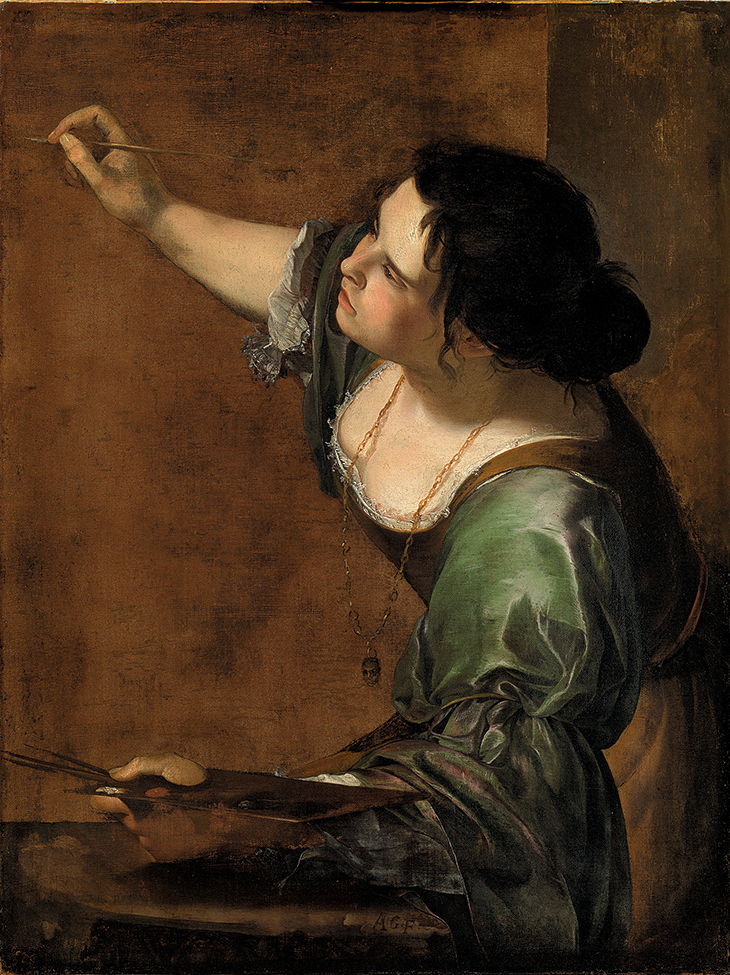
This work followed the standard emblematic handbook of the period, the Iconologia of Cesare Ripa. Published in 1593, the volume provided painters with a convenient index of allegorical figures, gestures, and attributes to be used in their work. Ripa describes the allegory of painting as a beautiful woman: her black hair is dishevelled, which is taken to signify ‘artistic temperament’; her mouth is covered by a cloth tied behind her ears, which shows that painting is dumb; from the chain of gold at her throat hangs a mask pendant, which symbolises the painter’s gift for imitation. Ripa also stipulates that the woman should be wearing drappo cangiante (clothes of shifting, shimmering fabric), in order to indicate the artist’s skill, and Artemisia’s painting accepts the challenge with virtuosity. There is only one point at which she diverges from Ripa’s archetype. Tellingly, she omits the gagged mouth, as though to say: Artemisia refuses to be silenced. Indeed, in painting this subject, Artemisia is able to use her gender to her advantage: she can depict herself in the allegory in a way that no man could. She is not just any old painter, this self-portrait tells us: rather, she is the embodiment of painting itself.
Elements of Ripa’s conventions of the allegory of painting are found in the works of her contemporaries. In Van Dyck’s Self-Portrait with a Sunflower (c. 1632–33), painted when he too had just arrived at the English court, we can see his dishevelled hair, his drappo cangiante, and the gold chain at his neck, though without the mask of imitation. This too is a kind of advert, but it says more about the artist’s elevated status than his need for patronage: the chain was in fact a gift from Charles I, and the sunflower faces him as though he were the sun. This is an extraordinary work, but Van Dyck cannot present himself as Artemisia does. He can signal towards, but he cannot embody, the allegory of painting, for the simple reason that he is a man. Artemisia’s success as an artist was both because of, and despite, her gender: she was a woman in a man’s world, but this made her distinct and she used this to her advantage throughout her career.
This was not the first time Artemisia had been cast as the allegory of painting. In the 1620s the French painter Simon Vouet had painted her palette in hand, brush poised to make its mark. She looks out at us, the viewer, as though we are the sitter for the portrait she is painting. As in the self-portrait from c. 1638–39, the canvas she is working on remains out of view. Her first ‘Allegory of Painting’, which dates from earlier in the 1630s, is also considered a self-portrait. It too has the painter looking out at her subject, and it too leaves her canvas offstage. She wears the necklace with a pendant mask and her hair escapes its band. But where the later self-portrait shows her deep in concentration, in her earlier treatment of the subject, her eyes stare out as she studies her subject, mouth open, brush held up in readiness.
Portrait of Artemisia Gentileschi (c. 1623–26), Simon Vouet. Photo: Gronchi Fotoarte; © Property of Fondazione Pisa
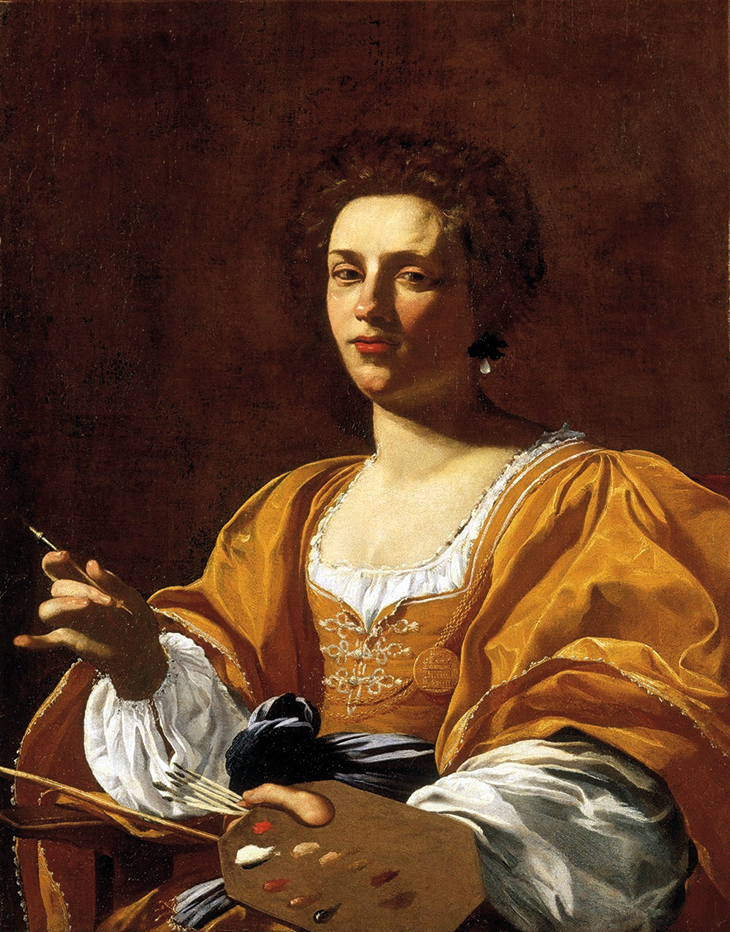
Her years in Florence constituted perhaps the pinnacle of her career. She was the first woman to be made a member of the Accademia delle Arti del Disegno, following in the footsteps of Michelangelo, Vasari, Bronzino. But the death of the Grand Duke Cosimo II de’ Medici in 1621 heralded a downturn in her fortunes. He was succeeded by his 10-year-old son Ferdinando, who was governed by his mother and paternal grandmother. They condemned Artemisia’s paintings, preferring their biblical figures perfect, penitent, with ethereal beauty where hers were raw and visceral. She left Florence, briefly returning to Rome before venturing to Venice. It is likely her first contact with English collectors, patrons, and art agents came at this time. In the mid 1620s, she first met Nicholas Lanier, who was master of music to Charles I, but also a painter and, most significantly, an art advisor to the king. He had been sent to Italy to broker the purchase of the Duke of Mantua’s collection. This purchase would form the bulk of the great royal collection in England, some of which was reunited in the Royal Academy’s exhibition ‘Charles I: King and Collector’ in 2018. It is possible that Artemisia helped Lanier choose the pieces he bought: by 1631 she was considered something of an expert in Venetian art and became an advisor to the Duke of Alcalá when he was buying works for his own collection. They are also rumoured to have been lovers at one time: Artemisia is known to have given Lanier a recipe for ‘amber varnish’, a gesture that suggests some intimacy, since painters usually kept their secrets close.
Painters were constantly competing for commissions and it could be difficult for them to know who to trust. Letters that Artemisia wrote to her patron, Don Ruffo, between September and December 1649, indicate many of the struggles of a self-sufficient artist: when asked for preliminary sketches of a ‘Judgment of Paris’ and a ‘Galatea’ she declares that she would never again send out drawings, after a bishop had given some of her sketches to another artist to execute. But Artemisia was strong and resilient: negotiating the sale of a ‘Diana at her Bath’, she warns Don Ruffo: ‘You will find the spirit of Caesar in this soul of a woman.’
The right hand of Artemisia Gentileschi holding a brush (1625), Pierre Dumonstier II. Photo: © The Trustees of The British Museum
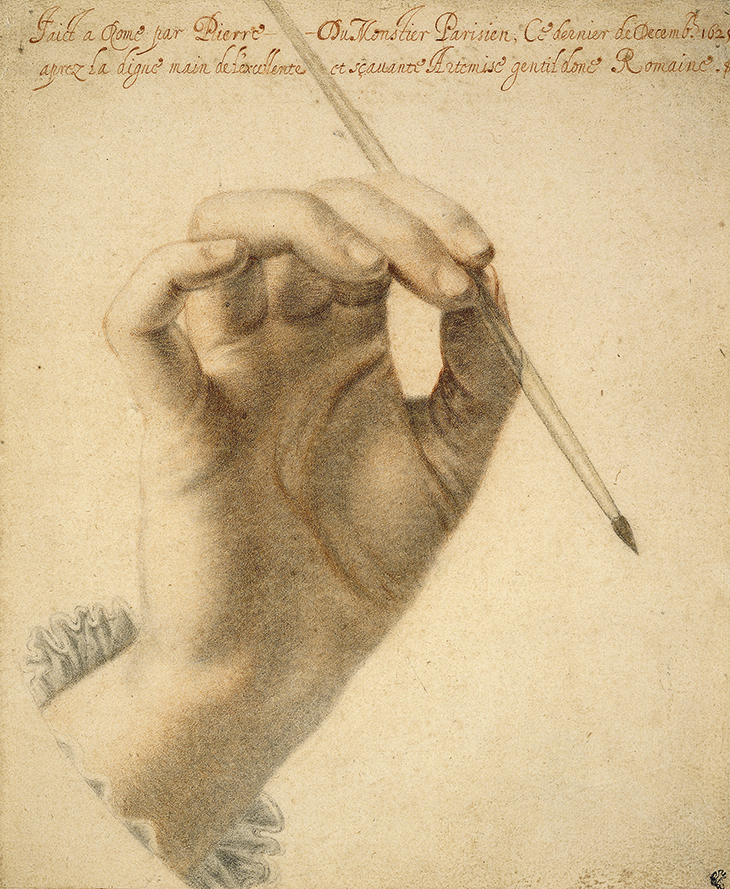
Even though the artist most readily associated with Charles I was Anthony Van Dyck, Charles’s great love was for Italian painting. From the beginning of his reign in 1625 he had sought an Italian painter for his court. The king’s favourite, George Villiers, Duke of Buckingham, first invited Orazio Gentileschi to England in 1626, and after Buckingham’s death in 1628, Orazio became court painter to Henrietta Maria: like Orazio, she had recently travelled to the English court from France, where Orazio had been court painter to her mother, Marie de Medici. The National Gallery’s acquisition of Artemisia’s Saint Catherine was recently followed by their acquiring one of the major works Orazio produced under Henrietta Maria’s patronage: The Finding of Moses, painted to commemorate the birth of her son, the future Charles II.
A tender sketch made by Van Dyck in around 1635, of the proud, but ageing, Orazio, suggests that there was no animosity, and perhaps even friendship, between the two artists. The expression in his eyes as he looks at the viewer suggests a fiery spirit, but the gentle resting of his right hand on his garment, as the left falls to his side, gesturing towards something just outside the canvas, implies something more placid. Gentileschi was, by all accounts, a difficult man to get on with. He and his sons often found themselves in trouble: crossed words, and sometimes crossed swords, meant that they gained a reputation for being hotheaded. Their particular feud with the Duke of Buckingham’s art agent, Balthazar Gerbier, was an unwise one: after the death of their mutual patron (Buckingham), Gerbier ensured he had the ear of the king, which cannot have helped Orazio’s attempts to gain favour.
It would appear that the king preferred the daughter to the father. When Artemisia arrived in London there were already three of her works in the Royal Collection. Even though he had been in London for more than a decade before her arrival, Orazio had only four pieces in the collection by this point, two of which were commissioned by, and made for, Henrietta Maria to decorate the Queen’s House in Greenwich.
Susannah and the Elders (1610), Artemisia Gentileschi. Kunstsammlungen Graf von Schönborn, Pommersfelden
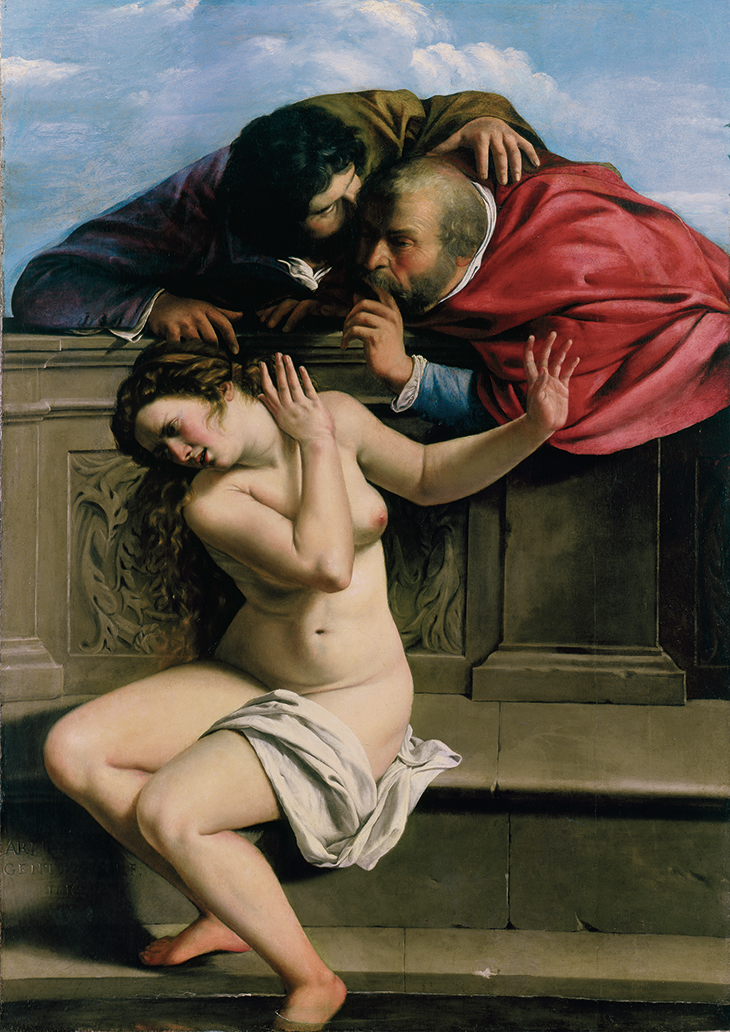
Artemisia had refused invitations to London for years. She was not the only Italian artist to resist Charles’s overtures: Guercino, who, like the Gentileschi, was working between Caravaggist realism and the early baroque, had responded to his invitation by saying that he would never go to a nation that was cold, damp, and full of heretics. Artemisia’s first invitation probably came in 1634, by which time she had settled in Naples. Somehow navigating her way through a world of plague and civil unrest, she was flooded with commissions for Judiths, Susannahs, Bathshebas, Mary Magdalenes, and self-portraits. As throughout her career, patrons didn’t just want an Artemisia on their walls; they wanted Artemisia herself.
Self-Portrait as a Lute Player (c. 1615–17), Artemisia Gentileschi. Wadsworth Atheneum Museum of Art, Hartford
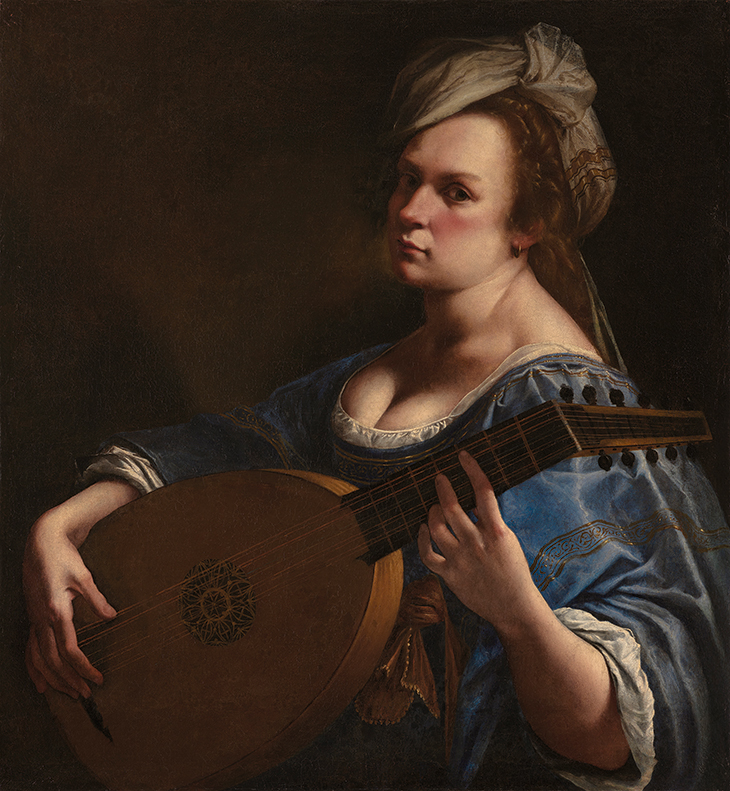
However, her professional success was not enough to keep her in Naples, as a letter of 11 February 1636 to Andrea Cioli, secretary to the Grand Duke of Tuscany, tells us: ‘I no longer want to stay in Naples,’ she wrote, ‘both due to the riots caused by the war and also to the poor standard of living.’ Throughout the 1630s she attempted to find alternative sources of patronage to Naples, while refusing to contemplate London. In January 1635, Artemisia wrote to Francesco d’Este, Duke of Modena, that Charles I had sent her brother, who was working for him as an art agent, to take her to England, but that she would rather accept D’Este’s patronage were he to offer it. He did not. In July she wrote to Ferdinand II de’ Medici telling him that her brothers would shortly be arriving in Florence to deliver to him paintings by her hand, with the hope of gaining his employment. These paintings were well received but no offer seems to have been made. When she eventually did depart for England in 1638, it was primarily to see her aged, ailing father.
Artemisia clearly did not take to life in England: not long after she arrived in London she was making plans to leave. In a letter to Francesco d’Este dated 16 December 1639, she wrote that her brother was on his way from England with a painting for the duke. She says that though she had received great honours from the English crown, she would gladly give them up to work for him in Modena. Again, her overtures came to nothing, and Artemisia remained in London until the eve of the civil war. It is not known exactly when she left England, but it is speculated that she was on the ship that took Marie de Medici to France in 1642.
Little evidence survives of what Artemisia produced in London, and concrete records of private commissions are hard to come by. The Greenwich ceiling painting (now at Marlborough House) has been subject to so much deterioration and restoration that it is difficult to pinpoint which parts may be by her hand. What we do know is that in the 1639 inventory of the royal collection, there were three paintings by Artemisia, whereas the inventory of the Commonwealth Sale – which sold off much of the collection after Charles I’s execution in 1649 – lists seven. Given that Charles had had to suspend his Continental art-buying spree during the civil war, it is safe to assume that four were produced during Artemisia’s stay in London. Six of the works were sold in the sale, with a ‘Bathsheba’ held back for Oliver Cromwell. Self-Portrait as the Allegory of Painting was bought back by Charles II after the Restoration, and remains in the Royal Collection to this day.
Attempts to connect the pieces in the inventory to surviving paintings by Artemisia have been largely unsuccessful. However, there is some speculation that a ‘Death of Cleopatra’ now with the Sarti Gallery in Paris and recently attributed to Artemisia is the same painting that was given the title ‘Saint laying his hand on fruit’ in the Commonwealth Sale inventory, and dates from her London period. Though the figure is clearly identifiable as the Egyptian queen – her hand lies beside the fruit, not on it, and the snake held between her fingers is slithering out of a basket of figs – the inventory was not drawn up by specialists, and even the transcription of ‘his’ in the title may have been an error. It may well be that the suicidal pagan queen had been mistaken for a saint.
Death of Cleopatra (c. 1640), Artemisia Gentileschi. Photo: Galerie Sarti, Paris
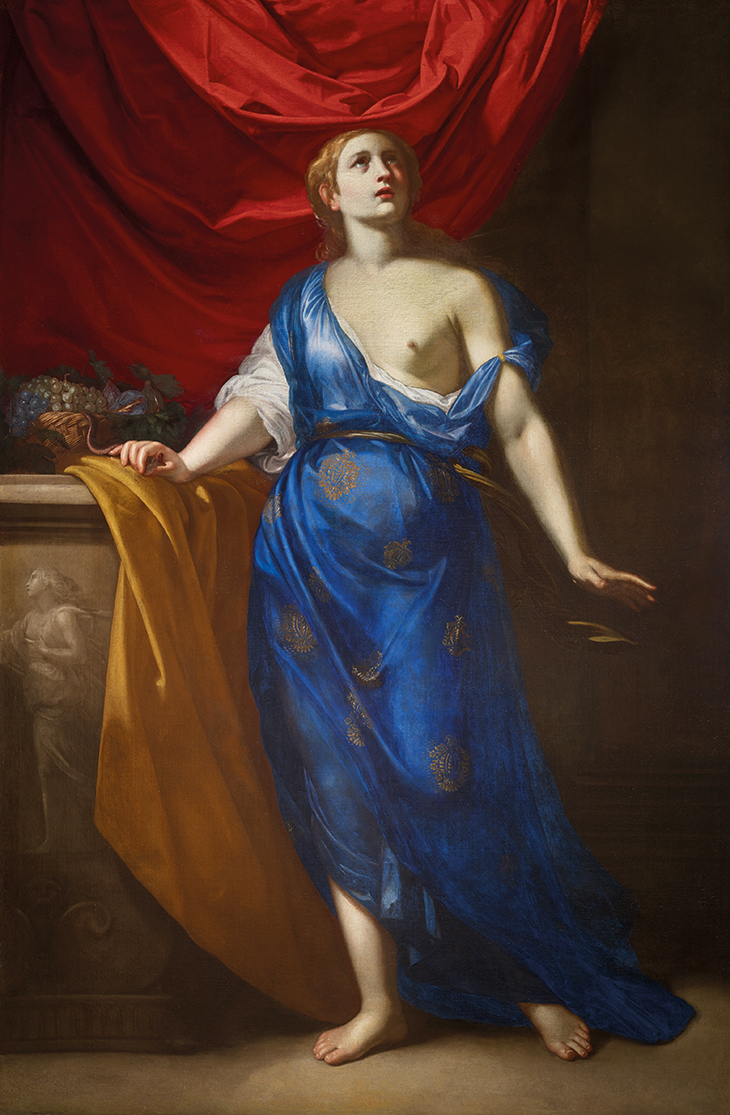
This rediscovery points to the tantalising possibility that more of Artemisia’s paintings from her London period remain to be identified. A particularly alluring suggestion concerns a painting titled Ulysses finding Achilles at the Court of King Lycomedes. Long considered a work by Orazio, in 2010 it was reattributed to Artemisia. Its confused attribution history is understandable, in that it contains many parallels with several of Orazio’s London works, such as The Finding of Moses, or Joseph and Potiphar’s Wife in the Royal Collection. The placement of the heads of the figures in an arc draws the viewer’s eye across the canvas, just as the hands of the women in his Moses painting pull one’s gaze to the basket. But the piece has telling signs of his daughter’s touch: the naturalistic features of the figures, particularly the women’s, and the textural use of light and shadow, most prominently found in the folds of fabrics.
It has since been speculated that the work is in fact a collaboration between father and daughter: when Artemisia arrived in London, she is believed to have taken over several of the works begun by her father, and completed them. The work Artemisia produced after her return to Naples appears to bear her father’s influence once more: perhaps in adapting her own style to finish his work, she re-absorbed some of his early teachings.
Self-Portrait as a Female Martyr (c. 1613–14), Artemisia Gentileschi. Private collection. Photo: courtesy the owner

The full story of Artemisia’s London years remains to be told: the extent of her commissions and patrons, what she produced and how she was received, remains unclear. It is only in the last few decades that scholars have started to rebuild her reputation, to restore lost and damaged works, and to develop a more detailed picture of her movements and commissions. The National Gallery retrospective is a watershed: the first in the UK to celebrate the painter’s work and to reunite many of her masterpieces. But it also points forward to future discoveries, as she once more takes her rightful place in the pantheon of the great Italian baroque artists.
From the March 2020 issue of Apollo. Preview the current issue and subscribe here.


